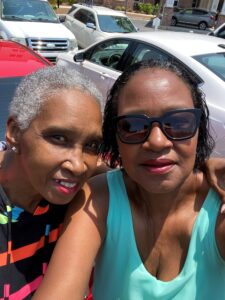
By Gina Mayfield
On Saturday, July 3, 2021, Kathy Simpson and her sister, Genny, spent the day celebrating the upcoming Fourth of July holiday with family and friends. The next evening, the two sisters decided to spend a quiet evening in their pajamas, snacking on leftovers from the party and watching Netflix at Genny’s apartment. “There was no indication that anything was wrong. Absolutely nothing,” Kathy says.
Just as the movie ended, Genny got up and walked down the hall to the bathroom. Kathy heard a loud crash. “The next thing I knew I was running so fast and saying, ‘Are you okay?’” Kathy says. She was met with silence. “I think I jumped over the couch. I just got this really weird feeling that something tragic had happened,’” she says. “I opened the bathroom door and Genny’s on the floor. She was unresponsive.”
Kathy frantically banged on neighbors’ doors while screaming for help. “Nobody came. Nobody opened their door. I knew time was crucial,” she says, having remembered a CPR class she had taken decades earlier. She called 911 and started chest compressions. EMTs finally arrived at her door after what “seemed like forever.”
Paramedics told Kathy she had done a great job, then worked on Genny for 20 – 30 minutes, before transporting her to the hospital, where Kathy gathered with the same family she had been celebrating with just the day before. Hours later, hospital staff asked them to step into a small room where a doctor delivered the devastating news that Genny had not survived cardiac arrest. “I’m sure I was in shock, traumatized, everything you can think of,” Kathy says.
She grieved for more than a year then decided she had to do something to honor Genny, who was a certified nursing assistant and a veteran who lost her life on the Fourth of July. Right before her sister’s death, Kathy had relocated to the Atlanta area to be closer to family and grow a business chauffeuring her 65-year-old Rolls-Royce, which was built for Buckingham Palace. “But when my sister died, that fell behind, it was no longer a priority. Saving lives became my mission,” Kathy says.
She found the strength to walk into an American Heart Association Training Center in Acworth, Georgia, which teaches on-site CPR classes. At first, she thought about just taking a class, then decided to inquire about becoming an instructor. She met with the manager, submitted her resume, eventually earned the Basic Life Support Instructor Certification and joined the training center staff in October 2023 as a BLS faculty member.
From there, she did a deep dive into CPR instruction and realized there were almost 4,000 CPR instructors currently employed in the United States. “But when I got down to Blacks, and I realized only 7.3% of instructors were Black or African American, my mouth just fell. I thought that was totally impossible. There’s no way this number could be that low. That was so disappointing,” Kathy says.
She went on to learn that Black or Hispanic adults who experience a witnessed cardiac arrest outside the hospital are substantially less likely than their white peers to receive lifesaving care from a bystander. “That crushed me. That changed everything,” she says.
Kathy made up her mind to reach people right where they were – at home during the pandemic. Realizing that hundreds of thousands of people lived in apartment complexes, she started there. Management teams were more than happy to support her efforts to teach CPR.
Kathy ordered everything she needed – manikins, masks, an AED, DVDs, training books – and began to volunteer her time to provide free Hands-Only CPR demonstrations right there in the complex’s community center. Everyone can afford free and they knew where to go, so neighbors of all ages, from kids to adults, were invited to practice calling 911 and apply 30 compressions on manikins. Kathy even stocked a Life Savers candy dispenser so participants could enjoy a sweet treat once they completed their training. “They didn’t have to leave the comfort of their own home. I came to them,” Kathy says.
Today, she’s teaching and volunteering her time at the seemingly endless number of apartments around Kennesaw State University. “I do this in honor of my sister,” she says, noting she still carries Genny’s photo in her instructor binder as a reminder of the importance of learning CPR.
And so, the crusade continues. “My goals are to continue teaching at the RC Health Services, continue the Hands-Only CPR demonstrations in the community and train people of color to become a CPR instructor,” Kathy says. “Imagine one apartment building. Just think of how many of those there are all over the United States. If we can get out there and offer Hands-Only demonstrations and BLS/CPR training that will be beneficial in a life-saving event for the entire community, we can give all people an opportunity to do something instead of nothing.”
